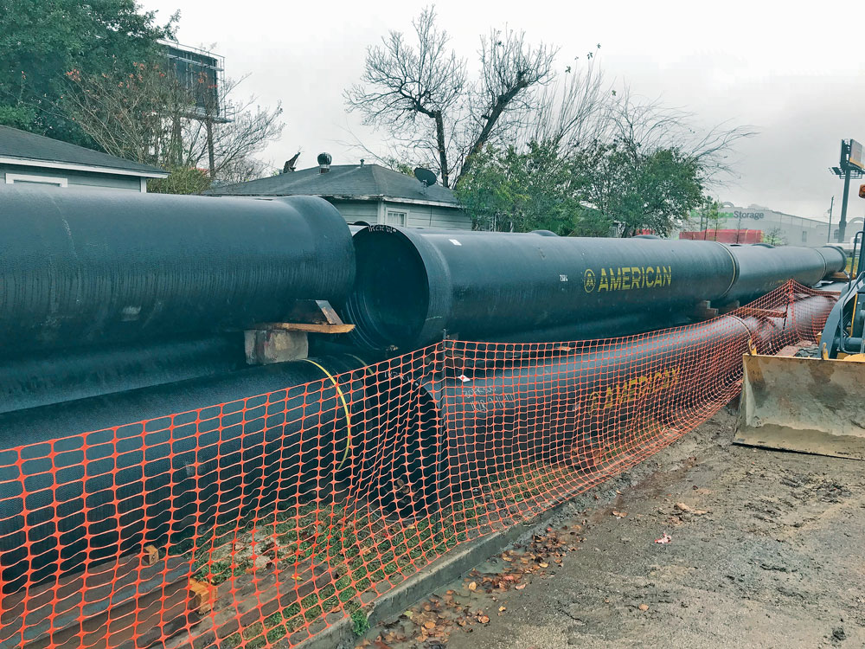2020 Trenchless Technology Pipe Selection Guide
Pipe is pipe, right? To say or believe that clearly shows that you are uninformed — and that is a description we do not want our readers to be. So, we are here to help.
Concrete. Ductile iron. Fiberglass reinforced. HDPE. Polymer concrete. PVC. Steel. Vitrified clay. These types of pipe are routinely the product pipe of choice on today’s trenchless projects. Deciding which pipe is best suited for any given trenchless project — whether it be sewer, water, gas or fiber optic/telecom — is an important part of the project design process. How do you know which will serve your needs the best?
To help you out,Trenchless Technologycontacted pipe associations and manufacturers of the eight pipes typically used in trenchless projects to showcase what their particular conduit offers. We have provided this valuable information several times in recent years, the last being in 2015. Some have changed in the five years, others have not but we are offering our valued readers an updated roundup of these pipe. As always, the information before you is only intended to give you a glimpse at the different pipe in the maraet. For more detailed information to see which pipe will work best for your project, please contact the manufacturer, pipe association or project engineer.
All the information presented was provided by the pipe associations or manufacturer.
CONCRETE

Jacking and microtunneling and instances where high compressive strength is needed for pushing a pipeline into its final location.
Best Suited For:
Precast concrete buried structure units are well suited for applications where high compressive forces are needed for the process of installation, such as jacking and microtunneling. Shapes, such as circular, elliptical, arch and rectangular box sections allow for a variety of choices to accommodate physical obstructions that may limit available space.
Not Well Suited For:
Concrete pipe is not well suited for applications having high internal pressure.
How Is It Delivered:
Precast concrete pipe and boxes are delivered in precast units that are ready for installation.
How Is It Joined:
Precast concrete pipe and box units can be supplied with soil resistant, silt resistant, and leak resistant joints. For microtunneling installations gasketed joints are typically used, along with a large bearing area in the joint for jacking forces.
Available Diameters:
Circular reinforced concrete pipe is available from 12 in. to 144 in. in diameter. Elliptical and Arch shapes are available for locations with limited vertical or horizontal clearance. These shapes have sizes equivalent to a 132-in. diameter circular pipe and less. Additionally, square and rectangular shapes are available in standard dimensions up to 12 ft by 12 ft, with larger nonstandard sizes available.
Design Life:
Concrete pipe has a proven service life of more than 100 years.
Latest Development over the Last Five Years:
Advancements in the use of cementitious materials and admixtures in the production of concrete pipe continue, providing greater strength and longer durability. Additionally, manufacturing equipment and processes continue to evolve and improve. ASTM standards for jacking and microtunneling pipe are being developed.
What Is Notable about Your Pipe:
Precast concrete pipe can be supplied in a variety of sizes, shapes, and strengths. When precast concrete pipe is specified and installed, there is less anxiety about conforming to product limitations and greater confidence in performing to expectations.
Source:American Concrete Pipe Association
Web:concrete-pipe.org
DUCTILE IRON PIPE

American ductile iron pipeTrenchless Applications:
Horizontal directional drilling, pipe bursting, microtunneling, and pipe jacking.
Best Suited For:
Water and wastewater pipeline installations, both gravity and pressure applications, and any installations that require a robust/strong pipe.
Ill Suited For:
There really isn’t a water or wastewater pipe project where ductile iron pipe would be ill suited.
How It Is Delivered:
Normally, 18- or 20-ft lengths. The standard push-on joint can also be cut in the field if shorter lengths are needed.
How It Is Joined:
For underground service, gasketed push-on joints are normally specified. In HDD applications, a restrained joint is needed – check with pipe manufacturers for recommendations. Other proprietary compression ring gasketed joints that facilitate trenchless applications. The push-on joint is deflectable (as much as 5 degrees) to facilitate HDD applications and routing the pipeline with minimal fittings.
Available Diameters:
3-in. diameter through 64-in. diameter (3, 4, 6, 8, 10, 12, 14, 16, 18, 20, 24, 30, 36, 42, 54, 60 and 64-in. diameters)
Design Life:
Indefinite when properly designed and installed.
Applicable Standards:
ANSI/AWWA C104/A21.4 – Cement-Mortar Lining for Ductile-Iron Pipe and Fittings
/AWWA C105/A21.5 – Polyethylene Encasement for Ductile-Iron Pipe Systems
ANSI/AWWA C110/A21.10 – Ductile-Iron and Gray-Iron Fittings
ANSI/AWWA C111/A21.11 – Rubber-Gasket Joints for Ductile-Iron Pressure Pipe and Fittings
ANSI/AWWA C115/A21.15 – Flanged Ductile-Iron Pipe with Ductile-Iron or Gray-Iron Threaded Flanges
ANSI/AWWA C116/A21.16 – Protective Fusion Bonded Coatings for the Interior and Exterior Surfaces of Ductile-Iron and Gray Iron Fittings
ANSI/AWWA C150/A21.50 – Thickness Design of Ductile-Iron Pipe
ANSI/AWWA C151/A21.51 – Ductile-Iron Pipe, Centrifugally Cast
ANSI/AWWA C153/A21.53 – Ductile-Iron Compact Fittings
ANSI/AWWA C600 – Installation of Ductile-Iron Mains and Their Appurtenances
ASTM A746 – Ductile Iron Gravity Sewer Pipe
ASTM A716 – Ductile Iron Culvert Pipe
RELATED: Tech Forum – Protecting Ductile Iron Pipe
Latest Development over the Last Five Years:
DIPRA has introduced a co-extruded polyethylene encasement for corrosion control. The V-Bio enhanced polyethylene encasement is infused with a corrosion inhibitor and an anti-microbial component to provide active corrosion control. DIPRA has also published, along with Corrpro Companies, a revised Design Decision Model (DDM®) for use in mitigating aggressive environments.
What Is Notable about Your Pipe:
“Successful trenchless installations have firmly established ductile iron pipe as a viable, and in many instances superior, pipe option. The advantages of using ductile iron pipe for trenchless installations include:
With the increasing demand for water and wastewater infrastructure and a movement to reduce the social-economic impact on rate payers that is often associated with open-cut construction, trenchless installation will certainly play an increasing role. For these installations, public works personnel and contractors have the option of installing superior ductile iron pipe.”
Source:Ductile Iron Pipe Research Association
Web:dipra.com
